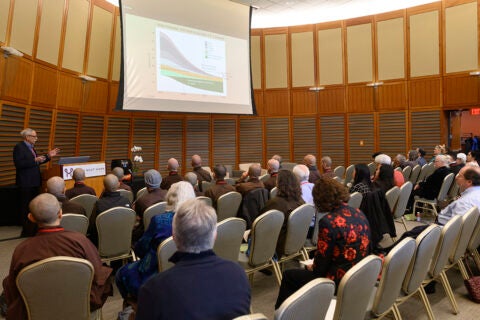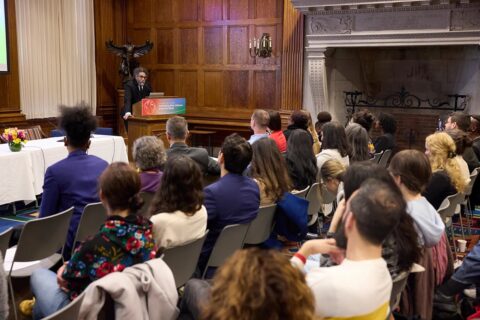Many new and complex issues are confronted in the conduct of infectious disease studies creating a need for novel statistical methods. CBAR’s location within the Department of Biostatistics provides a unique environment for novel methodological research. The Department of Biostatistics at HSPH is consistently rated the top Biostatistics Department in the world by US News and World Report. This provides the opportunity for methodologic development collaborations among many other statisticians with expertise in statistical methodology areas relevant to infectious studies. The Department’s extensive seminar series and working groups provide opportunities for CBAR statisticians to learn about recent advances in applications and methods.
Current foci include the design and analyses of studies with patient-focused outcome measures that integrate efficacy and safety outcomes, competing risks, personalizing treatment, and comparison of diagnostic technologies (e.g., point of care versus gold standard technologies).
CBAR researchers also focus on the development and application of sophisticated epidemiological models for evaluating treatment effects accounting for confounding by indication in observational studies. These include the use of inverse probability of treatment weighting (IPTW), marginal structural models, mediation analysis, and other causal inference approaches.
Methods papers
Bather JR, Horton NJ, Coull BA, Williams PL. The impact of correlated exposures and missing data on multiple informant models used to identify critical exposure windows. Stat Med. 2023 Apr 15;42(8):1171-1187. doi: 10.1002/sim.9664. Epub 2023 Jan 16. PMCID: PMC10023485 https://pubmed.ncbi.nlm.nih.gov/36647625/
Kang M, Kendall MA, Ribaudo H, Tierney C, Zheng L, Smeaton L, Lindsey JC. Incorporating estimands into clinical trial statistical analysis plans. Clinical trials (London, England). 2022 June;19(3):285-291. PubMed PMID: 35257600; PubMed Central PMCID: PMC9232859; DOI:10.1177/17407745221080463. https://pubmed.ncbi.nlm.nih.gov/35257600/
Nelson BS, Liu L, Mehta C. A simulation-based comparison of estimation methods for adaptive and classical group sequential clinical trials. Pharm Stat. 2022 May;21(3):599-611. doi: 10.1002/pst.2188. Epub 2021 Dec 26. PMID: 34957677. https://pubmed.ncbi.nlm.nih.gov/34957677/
Weir IR, Rider JR, Trinquart L. Counterfactual mediation analysis in the multistate model framework for surrogate and clinical time-to-event outcomes in randomized controlled trials. Pharm Stat. 2022 Jan;21(1):163-175. doi: 10.1002/pst.2159. Epub 2021 Aug 4. PMID: 34346173; PMCID: PMC8776584. https://pubmed.ncbi.nlm.nih.gov/34346173/
Weir IR, Wasserman S. Treatment Effect Measures for Culture Conversion Endpoints in Phase IIb Tuberculosis Treatment Trials. Clin Infect Dis. 2021 Dec 6;73(11):2131-2139. doi: 10.1093/cid/ciab576. PMID: 34254635; PMCID: PMC8664460. https://pubmed.ncbi.nlm.nih.gov/34346173/
Ryeznik Y, Sverdlov O, Svensson EM, Montepiedra G, Hooker AC, Wong WK. Pharmacometrics meets statistics-A synergy for modern drug development. CPT Pharmacometrics Syst Pharmacol. 2021 Oct;10(10):1134-1149. doi: 10.1002/psp4.12696. Epub 2021 Aug 19. PMID: 34318621; PMCID: PMC8520751. https://pubmed.ncbi.nlm.nih.gov/34318621/
Zheng L, Tierney C, Bosch RJ. Analytical Treatment Interruption in HIV Trials: Statistical and Study Design Considerations. Curr HIV/AIDS Rep. 2021 Jul 2;. doi: 10.1007/s11904-021-00569-8. [Epub ahead of print] Review. PubMed PMID: 34213731; PubMed Central PMCID: PMC8251690. https://pubmed.ncbi.nlm.nih.gov/34213731/
Tobin NH, Murphy A, Li F, Brummel SS, Taha TE, Saidi F, Owor M, Violari A, Moodley D, Chi B, Goodman KD, Koos B, Aldrovandi GM. Comparison of dried blood spot and plasma sampling for untargeted metabolomics. Metabolomics. 2021 Jun 23;17(7):62. doi: 10.1007/s11306-021-01813-3. PMID: 34164733; PMCID: PMC8340475. https://pubmed.ncbi.nlm.nih.gov/34164733/
White LF, Moser CB, Thompson RN, Pagano M. Statistical Estimation of the Reproductive Number From Case Notification Data. Am J Epidemiol. 2021 Apr 6;190(4):611-620. doi: 10.1093/aje/kwaa211. Review. PubMed PMID: 33034345; PubMed Central PMCID: PMC8244992. https://pubmed.ncbi.nlm.nih.gov/33034345/
Montepiedra G, Ramchandani R, Miyahara S, Kim S. A framework for considering the risk-benefit trade-off in designing noninferiority trials using composite outcome approaches. Stat Med. 2021 Jan 30;40(2):327-348. doi: 10.1002/sim.8777. Epub 2020 Oct 26. PMID: 33105524; PMCID: PMC7770022. https://pubmed.ncbi.nlm.nih.gov/33105524/



